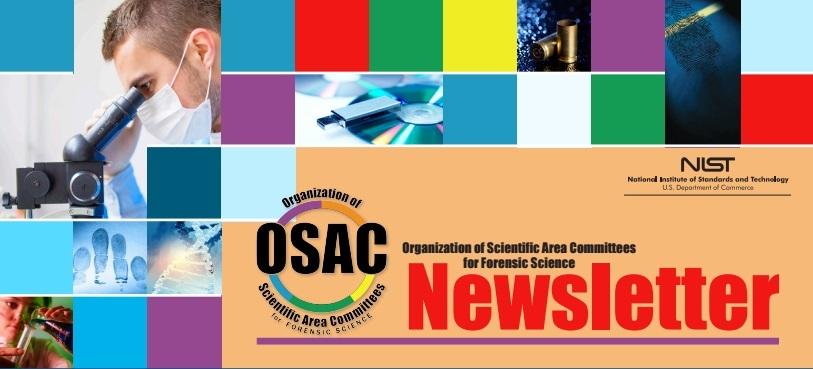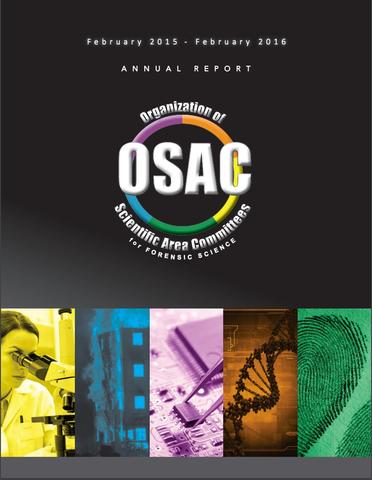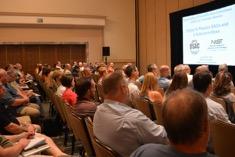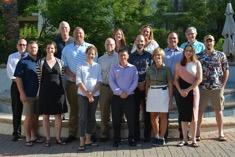OSAC Newsletter, September 2016

September 2016
Message from the OSAC Affairs Director: 2015-2016 OSAC ANNUAL REPORT PUBLISHED | Research & Development Needs | Message from the Forensic Sciences Standards Board (FSSB) | Recent OSAC Accomplishments | On the Horizon | Status of Standards and Guidelines for Inclusion on the OSAC Registries | Resource Committee Corner | Standards Developing Organization (SDO) News
Message from the OSAC Affairs Director: 2015-2016 OSAC ANNUAL REPORT PUBLISHED

The Organization of Scientific Area Committees for Forensic Science (OSAC) is an initiative of the National Institute of Standards and Technology (NIST) and the U.S. Department of Justice (DOJ). The purpose of OSAC is to strengthen the nation’s use of forensic science by:
- Providing technical leadership that facilitates the development and promulgation of consensus-based documentary standards and guidelines for forensic science;
- Promoting standards and guidelines that are fit-for-purpose and based on sound scientific principles;
- Promoting the use of OSAC standards and guidelines by accreditation and certification bodies;
- Establishing and maintaining working relationships with similar organizations.
The February 2015-February 2016 OSAC Annual Report is now available. The report documents OSAC’s program activities and accomplishments. In this timeframe, OSAC has:
- Increased interdisciplinary forensic science discussions;
- Worked on 155 different draft standards and guidelines projects related to forensic science;
- Published Version 1 of major OSAC processes, and shared process documents with the public;
- Posted one standard to the OSAC Registry of Approved Standards.
View the Annual Report on the OSAC website.
Research & Development Needs

The Biology/DNA Scientific Area Committee has four Research and Development Needs to contribute and Crime Scene/Death Investigation Scientific Area Committee has 24 Research and Development Needs to contribute.
In Biology/DNA--
Under the Biological Data & Interpretation Subcommittee:
• Assessment of Specific Classes of Evidence Types to Determine the Necessity to Quantify DNA Before Amplification of Human Autosomal STR Loci
• Characterizing, Designing and Constructing Integrated DNA Mixture Interpretation Solutions
• Proficiency Testing for Complex Data Interpretation and Biostatistical Evaluations
• Software Solutions for Y-STR Mixture Deconvolution
In Crime Scene/Death Investigation--
Under the Anthropology Subcommittee:
• Controlled Experimental Bone Trauma Studies
• Healing Rates of Skeletal Injury, Especially in Children
• Stable Isotope Analysis as a Geospatial Tool for Identification
• Validation Studies of Technologies (ex. ground penetrating radar, remote sensing) and Recovery Techniques in Forensic Anthropology
• Population Frequency Data for Radiologic Identification
Under the Disaster Victim Identification Subcommittee:
• Composite Quantification of Contextual Decedent ID Criteria
• Modeling of MFI Missing Person and Victim Data
• Understanding Cognitive Bias in DVI Operations
Under the Dogs and Sensors Subcommittee:
• Development of Methods for Monitoring Levels of Contamination of Aids
• Development of Reliable Surrogate Aids
• Evaluation of Dissipation of Odorant
• Identification of Odorant Chemicals Present in and above Targets
• Integration of Canine and Instrumental Detectors
Under the Medicolegal Death Investigation Subcommittee:
• Assessing the Utility of Autopsy in Contentious Medicolegal Categories of Death
• Geographic and Seasonal Variation of Postmortem Changes
• Medicolegal Death Investigator Workload Analysis
• Pediatric Forensic Pathology to Improve the Accuracy of Cause and Manner of Death Certification
Under the Odontology Subcommittee:
• 3D Imaging of Patterned Injuries on Human Skin
• Critical Comparison of Dental Age Assessment Methods
• Development of 3D Databases of Human Dentitions
• Phenotyping of Tooth Shape and Tooth Color
• Quality & Quantity of Concordant Features Required for Human Identification
• Reliability of Bitemark Analysis Methodology
• Specific Population Studies in Dental Age Assessment
Research & Development Needs can be found in greater detail on the NIST OSAC Research and Development Needs webpage.
Message from the Forensic Sciences Standards Board (FSSB)

In addition to these activities, the FSSB analyzed and voted on several of the recommendations made in the OSAC Leadership Strategy Session (OLSS). For example, in response to OLSS Recommendation #5, the FSSB approved some structural changes that would help facilitate more frequent and formal communication between the OSAC committees/stakeholder groups. Moving forward, the three resource committee chairs will be ex-officio members on the FSSB and will be invited to attend all FSSB meetings, and one representative from each resource committee will be invited as ex-officio members to each of the five Scientific Area Committees (SACs).
Many other OLSS recommendations were also approved in their original configuration or slightly modified configuration. These other pending changes will be announced after an implementation plan for each is put in place within the next few months.
Recent OSAC Accomplishments
• OSAC Full Meeting Breakouts Held – Phoenix, AZ July and August 2016
The Full OSAC Meetings Breakout sessions were held during July and August in Phoenix, Arizona. The purpose of these meetings was to work on ongoing OSAC projects related to identifying forensic science standards and guidelines that have technical merit and were developed through an approved standards development process to be elevated for listing on the OSAC Registries, analyzing and reporting research and development (R&D) needs, and to work on identifying and documenting forensic science terminology. These efforts help to support the development of scientifically valid standards that address issues within the forensic science disciplines and will ensure they incorporate the most recent research. The meetings included:
July 12-13: OSAC Breakout #1 – Resource Committees
July 26-29: OSAC Breakout #2 – Digital/Multimedia SAC and Physics/Pattern Interpretation SAC
August 2-5: OSAC Breakout #3 – Chemistry SAC
August 23-26: OSAC Breakout #4 – Biology/DNA SAC and the Crime Scene/Death Investigation SAC
The attendees of these meetings included representatives of the forensic science disciplines from government, academia, and private industry. These different perspectives within forensic science enable these standards to go through a review process that ensures technical merit and due process prior to the OSAC Registry of Approved Standards approval process.
These “in-person” collaborative sessions enable members of the OSAC to hold working group and strategy sessions for major topics that cannot be fully addressed virtually. For example, at the plenary of the last two meetings, Christopher J. Plourd, Superior Court Judge, State of California, Committee Chair and Ronald S. Reinstein, Judge and Judicial Consultant of the Arizona Supreme Court, provided a briefing to all in attendance on a judge’s responsibility in the courtroom. Additional benefits include the opportunity for members to coordinate and share information face to face across SACs and subcommittees on the development and promulgation of forensic science consensus documentary standards and guidelines that are being worked on through hundreds of virtual meetings conducted over the course of the year.
The overall impression of these meetings was that they were the most productive set of meetings held to date. Some testimonials include:
Richard Vorder Bruegge (Chair: Digital/Multimedia SAC): “The Phoenix meetings of the DMSAC and our subcommittees were extremely productive. The facilities were excellent, and the connectivity of the rooms—both physically and electronically—enhanced our ability to collaborate across subcommittees and SACs. That cross-discipline collaboration may be the greatest strength of OSAC and is a characteristic which should only grow over time. I hope we can continue to hold meetings with the Physics/Pattern Interpretation SAC.”
George Herrin (Chair: Biology/DNA SAC): “The Biology/DNA Scientific Area Committee meeting in Phoenix the week of August 22nd was a great success. Two documents from the Data Interpretation and Reporting subcommittee were completed and have now been submitted to the American Academy’s Standards Board. Several new task groups were formed in each subcommittee. A terminology document comprised of over 400 terms related to forensic biology was completed and submitted to the Quality Infrastructure Resource Committee for final review.”
Karen Reczek (Chair: Quality Infrastructure Committee): “The in-person meeting of the QIC was extremely productive and well attended. While we meet monthly via teleconference, there is no substitute for face time in terms of reaching consensus and discussing important issues. The QIC had some time to meet with the FSSB to ask questions and get direction, and some time was spent in a joint resource committee meeting with the HFC and LRC. Again, having the opportunity to meet with our colleagues and provide updates on activities is always beneficial.


Top: Attendees listen to plenary discussions at the Digital & Physics SAC and Subcommittee Meetings. Bottom: The newly formed Crime Scene Investigation Subcommittee meets for this first time this August in Phoenix, Arizona.
On the Horizon

• (Internal OSAC Meeting) FSSB, Dec. 1-2, 2016 in Atlanta, GA.
• (Open to the Public) OSAC Scientific Area Committees Public Status Reports & Open Discussions occur at the American Academy of Forensic Sciences (AAFS) in New Orleans, LA on Feb. 13-14, 2017. (Save the Date)
• (Internal OSAC Meeting) Full OSAC Meeting, April 2017 tentatively in Leesburg, VA.
Status of Other Standards and Guidelines Recommended for Inclusion on the OSAC Registries
The aim of the Organization of Scientific Area Committees (OSAC) for Forensic Science is to identify and promote technically sound, consensus-based, fit-for-purpose documentary standards that are based on scientifically accepted principles. This will be achieved through the OSAC Registry of Approved Standards and the OSAC Registry of Approved Guidelines. A standard or guideline that is posted on either Registry demonstrates that the methods it contains have been assessed to be valid by forensic practitioners, academic researchers, measurement scientists, and statisticians through a consensus development process that allows participation and comment from all relevant stakeholders.
Below is a listing of standards or guidelines that are under consideration for the OSAC Registries, along with their status in the approval process.
Standards and Guidelines Open for Public Comment
The intent of the public comment period is to collect public opinion on inclusion of the standard to the OSAC Registry (OSAC is not soliciting potential revisions to the documents themselves.)
The Chemistry/Instrumental Analysis SAC has submitted the following standard and the following guideline (Guide) for consideration to add to the respective OSAC Registry. The 30-day public comment period opened August 17 on the Kavi Public Workspace under "documents". The intent of the public comment period is to collect public opinion on inclusion of the documents on the relevant OSAC registry.
ASTM E2451-13 Standard Practice for Preserving Ignitable Liquids and Ignitable Liquid Residue Extracts from Fire Debris Samples (for consideration as an OSAC Guideline) - Comment Period Closes September 20, 2016 - Free review during comment period.
This practice describes procedures for preserving residues of ignitable liquids in extracts obtained from fire debris samples and questioned ignitable liquid samples.
Standards and Guidelines in Public Comment Adjudication Phase
Public comment period is closed for the following standards/guidelines as OSAC units review and adjudicate comments received.
ASTM E2388-11 Standard Guide for Minimum Training Requirements for Forensic Document Examiners (for consideration as an OSAC Standard)
This guide may not cover all aspects of training for the topics addressed or for unusual or uncommon examinations.
ISO/IEC 17020:2012 Requirements for the Operation of Various Types of Bodies Performing Inspection (for consideration as an OSAC Standard)
ISO/IEC 17020:2012 specifies requirements for the competence of bodies performing inspection and for the impartiality and consistency of their inspection activities.
It applies to inspection bodies of type A, B or C, as defined in ISO/IEC 17020:2012, and it applies to any stage of inspection.
Standards and Guidelines at SAC for Vote
There are currently no items at the SAC for Vote.
Standards and Guidelines at FSSB for Vote
ASTM E2330-12 Standard Test Method for Determination of Concentrations of Elements in Glass Samples Using Inductively Coupled Plasma Mass Spectrometry (ICP-MS) for Forensic Comparisons (for consideration as an OSAC Standard)
One objective of a forensic glass examination is to compare glass samples to determine if they can be discriminated using their physical, optical or chemical properties (for example, color, refractive index (RI), density, elemental composition). If the samples are distinguishable in any of these observed and measured properties, it may be concluded that they did not originate from the same source of broken glass. If the samples are indistinguishable in all of these observed and measured properties, the possibility that they originated from the same source of glass cannot be eliminated. The use of an elemental analysis method such as inductively coupled plasma mass spectrometry yields high discrimination among sources of glass. This test method covers a procedure for quantitative determination of the concentrations of magnesium (Mg), aluminum (Al), iron (Fe), titanium (Ti), manganese (Mn), rubidium (Rb), strontium (Sr), zirconium (Zr), barium (Ba), lanthanum (La), cerium (Ce), neodymium (Nd), samarium (Sm), and lead (Pb) in glass samples.
ASTM E2926-13 Standard Test Method for Forensic Comparison of Glass Using Micro X-ray Fluorescence (μ-XRF) Spectrometry (for consideration as an OSAC Standard)
This test method is for the determination of major, minor, and trace elements present in glass fragments. The elemental composition of a glass fragment can be measured through the use of μ-XRF analysis for comparisons of glass. This test method covers the application of μ-XRF using mono- and poly- capillary optics, and an energy dispersive X-ray detector (EDS).
NFPA 1033: Standard for Professional Qualifications for Fire Investigator, 2014 Edition (for consideration as an OSAC Standard)
This standard facilitates safe, accurate investigations by specifying the job performance requirements (JPRs) necessary to perform as a fire investigator in both the private and public sectors.
Standards and Guidelines in the Appeals Phase
The public appeals phase is open for the following standard. Appeals may only be submitted by individuals or groups that submitted a comment during the open public comment phase that believe their comment was not properly adjudicated. Submitted appeals must relate to the comment adjudication process, not technical issues.
ASTM E2548-11e1 Standard Guide for Sampling Seized Drugs for Qualitative and Quantitative Analysis (for consideration as an OSAC Standard)
This guide covers minimum considerations for sampling of seized drugs for qualitative and quantitative analysis.
Standards and Guidelines Returned to SDO for Modifications Based on Comments
After careful consideration of the comments from the either the public and/or other OSAC committees, the OSAC has elected to submit the following documents to the SDO for revisions prior to proceeding through the OSAC process. They believe the issues raised during the comment period can be addressed by the SDO, and intend to bring the updated standards back through the OSAC Registry Approval Process.
ASTM E2881-13e1 Standard Test Method for Extraction and Derivatization of Vegetable Oils and Fats from Fire Debris and Liquid Samples with Analysis by Gas Chromatography-Mass Spectrometry (for consideration as an OSAC Standard)
This test method covers the extraction, derivatization, and identification of fatty acids indicative of vegetable oils and fats in fire debris and liquid samples. This procedure will also extract animal oils and fats, as these are similar in chemical composition to vegetable oils and fats. Herein, the phrase "oils and fats" will be used to refer to both animal and vegetable derived oils and fats. This test method is suitable for successfully extracting oil and fat residues having 8 to 24 carbon atoms.
ASTM E2916-13 Standard Terminology for Digital and Multimedia Evidence Examination (for consideration as an OSAC Guideline)
This document provides standard terminology for the subcommittees of Digital Evidence, Facial Identification, and Video Imaging Technology and Analysis.
ASTM E2825-12 Standard Guide for Forensic Digital Image Processing (for consideration as an OSAC Standard)
This document provides digital image processing guidelines to ensure the production of quality forensic imagery for use as evidence in a court of law. It briefly describes advantages, disadvantages, and potential limitations of each major digital imaging process.
ASTM E1610-14 Standard Guide for Forensic Paint Analysis and Comparison (for consideration as an OSAC Guideline)
This guide is designed to assist the forensic paint examiner in selecting and organizing an analytical scheme for identifying and comparing paints and coatings. The size and condition of the sample(s) will influence the selected analytical scheme.
ASTM E2937-13 Standard Guide for Using Infrared Spectroscopy in Forensic Paint Examinations (for consideration as an OSAC Guideline)
This guide applies to the forensic IR analysis of paints and coatings and is intended to supplement information presented in the Forensic Paint Analysis and Comparison Guidelines (1)2 written by Scientific Working Group on Materials Analysis (SWGMAT). This guideline is limited to the discussion of Fourier Transform Infrared (FTIR) instruments and provides information on FTIR instrument setup, performance assessment, sample preparation, analysis and data interpretation.
Resource Committee Corner
QIC Update by Karen Reczek
The last QIC update was in June 2016 and the Committee has been actively working on several initiatives via task groups.
The Registry Management Task Group successfully finalized the Registry Management Process. This procedure outlines the steps to remove, update or replace a document that is currently on the OSAC Registries. The FSSB issued this procedure on August 5, 2016.
The QIC Comment Adjudication Procedure Task Group has revised the Comment Adjudication Procedure and has added an Annex on Comment Adjudication Guidance. The proposed revision will be finalized in early October 2016.
The QIC Standards Procedures and Process Task Group is working on the next iteration of the Technical Merit Worksheet. The new version of the form will include a section to capture comment adjudication at all stages from the Registry Approval Process (Technical Merit Worksheet voting, all the way through the SAC vote for final Registry approval.) This is to ensure that all negative comments and adjudication are documented, so that the FSSB has all the information regarding issues and concerns and how they have been addressed before their final approval vote. Other changes to the Worksheet include requiring explanation for all “Yes”, “No”, and “Not Applicable” responses. The new version of the Worksheet will also add more explicit questions regarding references, method validation, uncertainty and limitations.
The QIC Impact Task Group has finalized the Impact Survey. The survey will be administered by ASCLD and will be released for the first time when the next document is ready to go out for Public Comment for Registry Approval. Once the results are compiled, the Task Group will issue an impact assessment report that will go to the FSSB along with other documents associated with Registry approval.
The QIC OSAC Terminology Task Group has received most of the terminology worksheets from the SACs. The Task Group is going to outline a proposed methodology for analysis and then will begin sifting through the terms. All terms provided will be imported into an Access database for ease of manipulation. The Task Group does not have a time frame for project completion.
The QIC met in-person in Phoenix in July and had a very productive meeting. The QIC continues to serve as a resource for the OSAC units and it welcomes any questions or feedback.
Standards Developing Organization (SDO) News
ASTM Committee E30 on Forensic Sciences Recent Activity
E30.1 Criminalistics
The following work items are underway:
Proposed Revision - WK55615 Standard Guide for Forensic Digital Image Processing is a work item revision to existing standard E2825 – 12
Proposed Revision - WK55542 Standard Terminology for Digital and Multimedia Evidence Examination is a work item revision to existing standard E2916 – 13 (LINK EXPIRED)
Proposed Revision - WK55598 Standard Guide for Forensic Paint Analysis and Comparison is a work item revision to existing standard E1610 – 14
Proposed Revision - WK55604 Standard Practice for Identification of Seized Drugs is a work item revision to existing standard E2329 – 14 (LINK EXPIRED)
Proposed Revision - WK55599 Standard Guide for Using Infrared Spectroscopy in Forensic Paint Examinations is a work item revision to existing standard E2937 – 13 (LINK EXPIRED)
The American Academy of Forensics Science (AAFS) Academy' Standards Board (ASB) has publicized their upcoming Consensus Body meetings.
All Consensus Body meetings are open to all interested parties, but only members may vote. For the full calendar, call-in information and agenda, visit the ASB Online Calendar of Events.
Medicolegal Death Investigation Consensus Body
Fri, Sep 16 2016 1:00 pm to 4:00 pm EDT
Bloodstain Pattern Analysis Consensus Body
Tue, Sep 20 2016 2:00 pm to 5:00 pm EDT
Forensic Document Examination Consensus Body
Thu, Sep 22 2016 1:00 pm to 4:00 pm EDT
Disaster Victim Identification Consensus Body
Fri, Sep 23 2016 1:00 pm to 4:00 pm EDT
Wildlife Forensics Consensus Body
Thu, Sep 29 2016 2:00 pm to 5:00 pm EDT
Friction Ridge Consensus Body
Mon, Oct 3 2016 1:00 pm to 4:00 pm EDT
Toxicology Consensus Body
Wed, Oct 12 2016 1:00 pm to 4:00 pm EDT
DNA Consensus Body Meeting
Thu, Oct 20 2016 3:00 pm to 6:00 pm EDT

